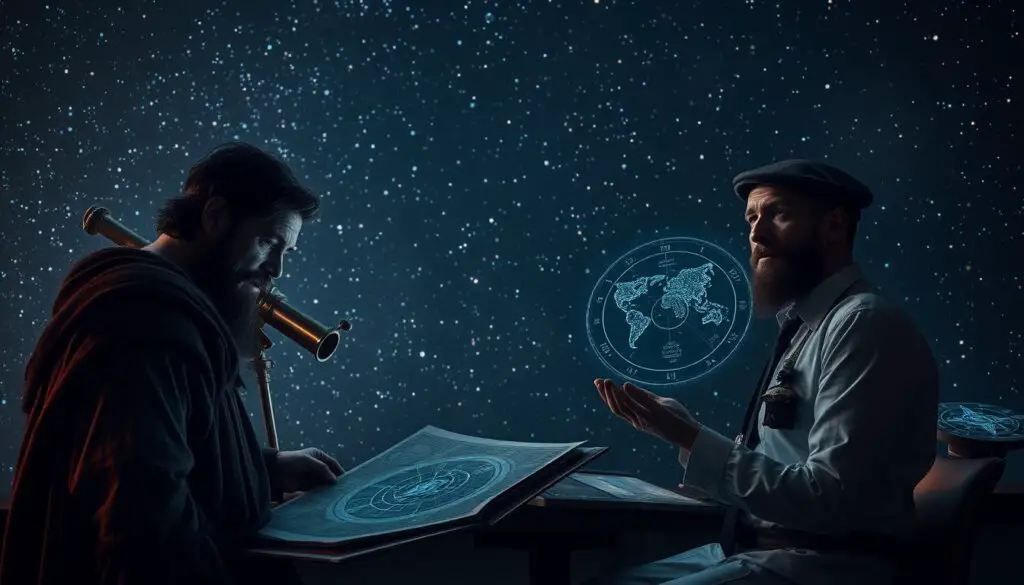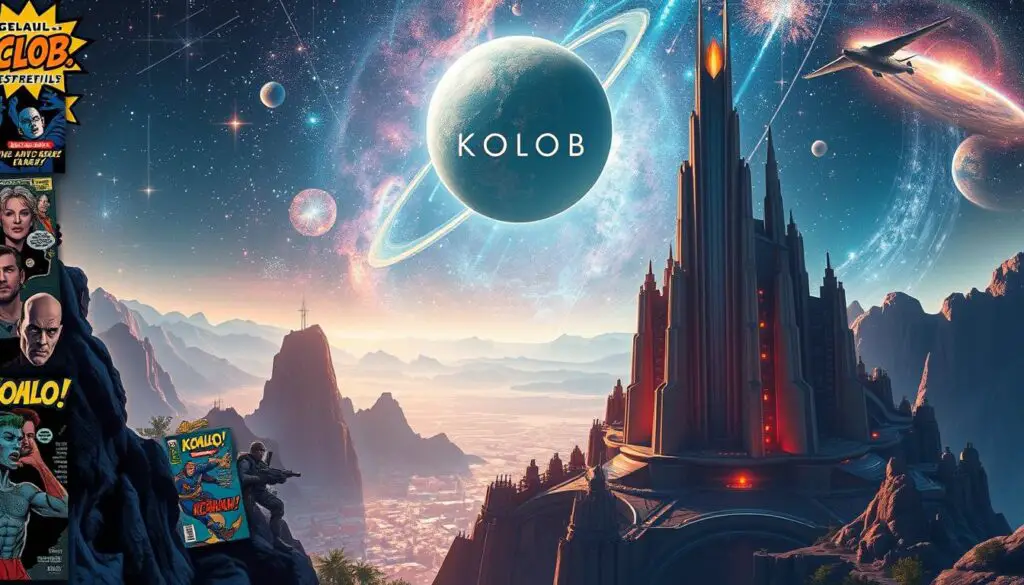Have you ever wondered about the mysteries of the cosmos through a spiritual lens? Among the unique teachings within the faith tradition founded by Joseph Smith, few concepts spark as much curiosity as Kolob. Described in the Book of Abraham as the celestial body “nearest to the throne of God,” this enigmatic star or planet holds a central place in theological discussions.
Joseph Smith’s translation of ancient Egyptian papyri in the 1830s introduced Kolob as a governing orb tied to divine timekeeping. According to scripture, one day near Kolob equals a thousand years on Earth—a detail blending astronomy with sacred narrative. Yet its exact nature remains debated: Is it a literal star, a symbolic place, or something beyond human understanding?
This article explores Kolob’s role in scripture, hymns like If You Could Hie to Kolob, and its cultural impact. We’ll also examine how scholars reconcile these ideas with modern science. Whether you’re new to the topic or seeking deeper insights, join us as we uncover the layers of meaning behind this celestial cornerstone.
Key Takeaways
- Kolob is described in the Book of Abraham as the heavenly body closest to God’s realm.
- Joseph Smith’s translations of ancient texts form the basis of its theological significance.
- Debates continue about whether it represents a star, planet, or metaphorical concept.
- The celestial body appears in Mormon hymns and inspires cultural references.
- Its connection to time measurement bridges spiritual and scientific discussions.
Understanding Kolob in Mormon Cosmology
What shapes a faith’s vision of the universe? For Latter-day Saints, ancient texts translated by Joseph Smith in the 1830s offer a unique cosmic blueprint. Central to this framework is a governing star described in the Book of Abraham, a text regarded as scripture.
Historical and Scriptural Origins
The Pearl of Great Price, which includes the Book of Abraham, states this celestial body was the “first in government” and closest to divine presence. Smith’s translations of Egyptian papyri positioned it as the anchor of a sacred timekeeping system—one day here equals 1,000 Earth years.
Celestial Governance and Order
Scripture paints a hierarchy where this star oversees other heavenly bodies. Called the “first creation,” it sits at the pinnacle of cosmic organization. Early writings suggest its role isn’t just physical but symbolic, reflecting proximity to divine authority.
This idea reshaped how believers viewed the cosmos. Hymns like If You Could Hie poetically explore endless creation cycles tied to this model. While interpretations vary, the concept remains a cornerstone of celestial theology.
Scriptural Insights from the Book of Abraham
How do ancient texts shape our understanding of the divine? The Book of Abraham offers a fascinating glimpse into celestial truths revealed through Joseph Smith’s work. His translation of Egyptian papyri in 1835 became foundational to this scripture, blending spiritual vision with symbolic astronomy.

Joseph Smith’s Revelation and Translation Process
Smith described receiving divine guidance while studying the papyri. He noted that certain hieroglyphs held deeper meanings about heavenly bodies. One passage states: “Kolob… is set nigh unto the throne of God,” framing it as the governing star overseeing lesser orbs.
The text details unique time measurements tied to this celestial body. For example, one revolution equals 1,000 Earth years. This aligns with explanations in Facsimile No. 2, which visually maps cosmic relationships.
| Time Measurement | Kolob | Earth |
|---|---|---|
| 1 Day | 1,000 Earth years | 24 hours |
| 1 Year | ~365,000 Earth years | 365 days |
Early scholars debated whether these details were literal or symbolic. Some saw the star as a physical planet, while others viewed it as a metaphor for divine order. The hymn If You Could Hie to Kolob reflects this tension, asking listeners to ponder endless creation cycles.
Regardless of interpretation, the Book of Abraham anchors its explanation in sacred timekeeping. It positions Kolob as the “first creation,” a title emphasizing its primacy in both scripture and cosmic design.
mormon kolob: Star or Planet Debate
How do sacred texts resolve cosmic mysteries? The Book of Abraham describes a governing celestial body using terms that spark modern debates. Is it a star blazing with light or a planet anchoring divine order? Let’s explore the evidence.
Exploring the Textual Descriptions
Scripture calls this orb both a “star” and part of a planetary system. The Pearl of Great Price states it governs others “which belong to the same order.” Ancient writings also note its unique timekeeping role—one revolution equals 1,000 Earth years.
Brigham Young argued for a literal interpretation: “If you could see the planets, you would see them in order.” Orson Pratt, however, saw it as a star “central to God’s creations.” These early leaders highlighted the text’s flexible language.
Diverse Interpretations in LDS Thought
Modern theologians often view the descriptions symbolically. B.H. Roberts suggested the creation account reflects spiritual truths rather than physical maps. Yet hymns like If You Could Hie keep literal imagery alive, blending science and faith.
This tension shows how scripture invites layered understanding. As one scholar noted: “The throne of God isn’t bound by human definitions.” Whether star, planet, or metaphor, the idea underscores divine organization beyond earthly limits.
Exegesis and Speculative Astronomy of Kolob
Ancient stargazers and modern scientists both seek patterns in the cosmos—but what happens when sacred texts enter the conversation? The Book of Abraham describes a governing planet tied to divine order, sparking debates that bridge scripture and astrophysics.

Cosmic Models Through Time
Early believers envisioned a universe anchored by a central celestial body, mirroring Babylonian and Egyptian star maps. One LDS scholar noted: “Ancient astronomy sought divine connections, not just physical coordinates.” This perspective frames Kolob as both a literal planet and a metaphor for God’s throne.
Modern theorists propose bold identifications—like Polaris or the Milky Way’s core. These ideas clash with scripture’s time measurements, where one day equals 1,000 Earth years. As physicist Richard Bushman observed: “Sacred creation narratives prioritize meaning over scientific precision.”
| Concept | Ancient View | Modern Theory |
|---|---|---|
| Central Body | Divine governance | Galactic Center |
| Time Scale | 1 day = 1,000 years | Relativity frameworks |
| Purpose | Spiritual hierarchy | Gravitational order |
This tension reveals a deeper truth: faith and science ask different questions. While telescopes map planets, scripture explores humanity’s place in God’s design. As Brigham Young taught,
“The matter of heaven operates by laws beyond our reckoning.”
Ultimately, Kolob’s mystery persists—not as a puzzle to solve, but a symbol inviting wonder at the universe’s endless complexity.
Theological Implications and Divine Symbolism
What if the universe holds keys to understanding divine nature? For Latter-day Saints, celestial symbols in scripture reveal profound truths about God’s relationship with creation. The Pearl of Great Price offers one such metaphor—a governing celestial body reflecting Christ’s eternal role.
Christ as the Cosmic Anchor
Scholars note striking parallels between this heavenly orb and Jesus Christ. Both are called “the firstborn” and described as nearest to the Father’s throne. Just as it oversees other stars, Christ governs all creation—a truth echoed in Doctrine and Covenants: “He is before all things, and by Him all things consist.”
The unique time measurement—one day equaling 1,000 Earth years—symbolizes divine eternity. This mirrors scriptural phrases like “one day is with the Lord as a thousand years,” emphasizing God’s transcendence over temporal limits.
| Symbol | Kolob | Jesus Christ |
|---|---|---|
| Position | Nearest to God | “Right hand of the Father” |
| Role | Governs stars | Governs creation |
| Time | 1 day = 1,000 years | “Alpha and Omega” |
Light imagery further deepens this connection. The Pearl of Great Price describes this body as radiating pure light, much like Christ being “the light of the world.” LDS apologist John Widtsoe wrote:
“Divine symbols teach us to seek higher laws—both in heaven and within.”
For believers, this cosmic order invites reflection. If God’s planet operates by perfect principles, how might individuals align their lives with divine patterns? The answer lies not in stargazing, but in embracing the Savior’s teachings as the ultimate guide.
Kolob in Popular Culture and Media
Celestial symbols often inspire earthly creativity. From hymns to sci-fi lore, the idea of a divine cosmic order has left its mark far beyond religious texts. Let’s explore how this concept shaped art, geography, and storytelling.

Hymns, Literature, and Television References
The hymn “If You Could Hie to Kolob” debuted in the 19th century. Written by W.W. Phelps, it poetically asks listeners to ponder eternal creation cycles. Its lyrics echo themes from the Book of Abraham, like divine time scales where “one day” spans a thousand years.
Science fiction embraced these ideas too. The reimagined Battlestar Galactica series featured “Kobol,” a lost homeland of stars. Though fictionalized, it mirrored theological debates about humanity’s origins and celestial governance.
Even landscapes carry the imprint. Utah’s Kolob Canyons, named by early Latter-day Saints, evoke otherworldly beauty. The red-rock formations remind visitors of scriptural descriptions linking earthly wonders to heavenly patterns.
These adaptations show how sacred ideas spark imagination. As one historian noted: “Myths become mirrors—reflecting our endless quest to map the unknown.” Whether through music or mountains, the legacy of early cosmic visions endures.
Conclusion
Exploring celestial mysteries often reveals how faith and curiosity intersect. The star described in sacred texts sparks fascination—not just as a physical planet or symbolic throne, but as a bridge between divine order and human wonder. Its unique time measurements, where one day equals a thousand years on earth, remind us that spiritual truths often transcend earthly limits.
Scholars still debate whether this celestial body anchors a literal solar system or represents God’s governance. Yet its connection to Jesus Christ as the “firstborn” of creation offers profound symbolism. Like light guiding stars, these teachings invite reflection on humanity’s place in a vast cosmos.
From hymns to canyon names, this idea continues inspiring art and exploration. Whether seen through scripture or science, it challenges us to seek deeper understanding. For those intrigued by these things, studying ancient texts might illuminate new layers of meaning—and perhaps spark fresh awe at the universe’s grand design.
FAQ
What is Kolob according to Latter-day Saint beliefs?
In Latter-day Saint teachings, Kolob is described as a celestial body near God’s presence. The Book of Abraham mentions it as a governing star or planet linked to divine timekeeping and creation.
How does the Book of Abraham explain Kolob’s role?
The text states Kolob is the “first creation” and closest to God’s throne. It symbolizes order in the cosmos and serves as a reference point for understanding God’s relationship to time and space.
Is Kolob considered a star or a planet?
Descriptions vary. The Book of Abraham refers to it as a “star” but also associates it with planetary terms. Latter-day Saint scholars often view it as a symbolic or literal body within a unique heavenly framework.
Did Joseph Smith provide scientific details about Kolob?
Joseph Smith’s revelations focused on theological concepts, not scientific specifics. The Book of Abraham emphasizes spiritual truths rather than offering astronomical data, leaving room for interpretation.
How does Kolob relate to time in LDS teachings?
The scripture states one day on Kolob equals 1,000 Earth years. This metaphor highlights God’s eternal nature and the vast difference between mortal and divine perspectives.
Are there hymns referencing Kolob in LDS worship?
Yes, the hymn “If You Could Hie to Kolob” explores themes of eternity and divine exploration. It reflects doctrinal ideas but isn’t used as frequently in modern worship services.
Do Latter-day Saints believe Kolob is Jesus Christ’s home?
While not explicitly stated, some interpretations connect Kolob to Christ’s role as Creator. However, official teachings focus more on its symbolic representation of God’s authority and the cosmos.
Has the LDS Church clarified Kolob’s physical existence?
The Church emphasizes its symbolic and revelatory significance over literal astronomy. Leaders encourage focus on core doctrines like Jesus Christ’s Atonement rather than speculative details.